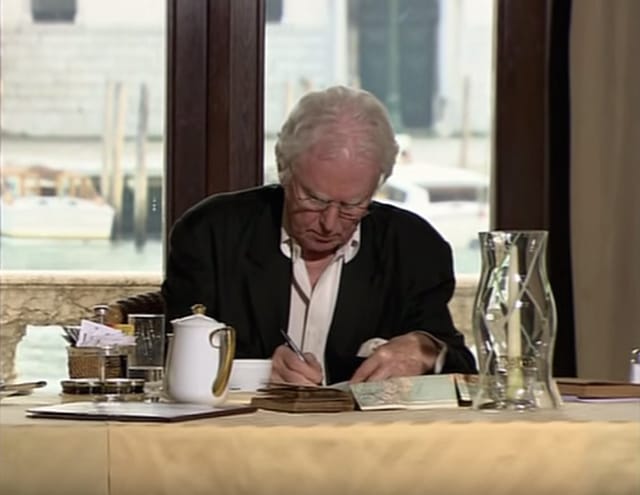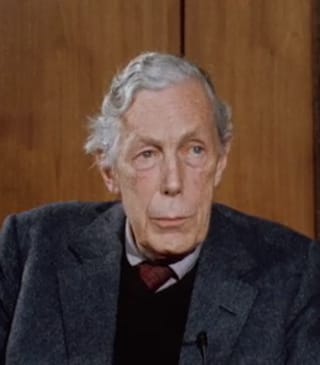Remembering Brian Sewell: The Master of the Operatic Put-Down Who Masturbated for Dalí
There's little doubt that Brian Sewell (1931–2015) — who passed away on Saturday — was Britain's best-known art critic.

There’s little doubt that Brian Sewell (1931–2015) — who passed away on Saturday — was Britain’s best-known art critic. Those who didn’t know his name recognized him as the television presenter whose plummy accent was “posher than the Queen[‘s]” (Sewell himself likened his voice to that of an “Edwardian lesbian“). Contemptuous of most contemporary art, Sewell’s operatic put downs of artist’s such as Damien Hirst and Tracey Emin were eagerly lapped up by the British public, though a deplorable and shameless strand of misogyny marred much of his writing.

Sewell was catapulted into public consciousness in November 1979 when he defended his former tutor and friend, Sir Anthony Blunt (1907–1983), during his exposure as a former Soviet spy. Blunt, who had previously served as a director of The Courtauld Institute of Art as well as the Surveyor of the Queen’s Pictures had been a member of the so-called “Cambridge Five.” Although Blunt had privately confessed to the British security services in 1964, the then newly elected prime minister Margaret Thatcher decided to publicly reveal Blunt’s role — part of a press campaign to demonstrate her lack of tolerance for governmental secrecy and unaccountability. Sewell, who despite persistent rumors, insisted that he and Blunt were friends and never lovers, conducted interviews with the press, whilst shielding Blunt from the prying eyes of photographers and journalists.
In the wake of the furor, Tina Brown, then editor of Tatler, appointed Sewell as the magazine’s art critic. Sewell later declared his role as a critic as “the sad end to a once promising career,” a tacit acknowledgement that he would have preferred to have been a renowned art historian. Sewell, who once described the 17th century as his favorite period of art, attracted acolytes who bemoaned the decline of connoisseurship in art historical studies and criticism. In an interview with the BBC, Sewell described himself as a failure. “I wanted to write the great book on Michelangelo and I never got anywhere near it. Now it’s too late.”
In 1984, Sewell succeeded Richard Cork as the art critic for London’s Evening Standard newspaper. The appointment dismayed many in the British art world, since unlike Cork, Sewell had little regard for cutting-edge art. In 1994, the Evening Standard published a letter signed by a group of artists, dealers, and critics — including Bridget Riley, Eduardo Paolozzi, Rachel Whiteread, Sarah Kent, Karsten Schubert, and Maureen Paley — accusing Sewell of “formulaic insults,” “artistic prejudice,” homophobia, and misogyny. The letter did little to dent Sewell’s popularity and most likely fed the public appetite for Sewell’s later television appearances.
Sewell was frequently lampooned as a harmless posh “queer” (his preferred term), which partly explains the impunity with which he delivered his most offensive comments. In 2008, he told the Independent:
The likes of Bridget Riley and Louise Bourgeois are of the second and third rank. There has never been a first-rank woman artist. Only men are capable of aesthetic greatness. Women make up 50 per cent or more of classes at art school. Yet they fade away in their late 20s or 30s. Maybe it’s something to do with bearing children.
Whether such comments stemmed from a well of genuine, virulent misogyny, or were simply the remarks of a man who took pleasure in provocation, is hard to say. The quote was profoundly idiotic, and unbecoming of Sewell’s intelligence. The critic was at his best when he skewered the art world’s most sacrosanct or popular stars.
On Damien Hirst‘s No Love Lost (Wallace Collection, 2009–2010):
… discounting these Baconian tricks of presentation and concentrating only on the canvases, we have nothing but the wretched incomprehensions of the first-year student cribbing from an acknowledged master … I take this as licence, for this occasion only, to declare this detestable exhibition fucking dreadful.
On David Hockney’s A Bigger Picture (Royal Academy, 2012):
… half these pictures are fit only for the railings of Green Park, across the way from the Royal Academy, and would never be accepted for the Summer Exhibition were they sent in under pseudonyms.
On Banksy:
Any fool who can put paint on canvas or turn a cardboard box into a sculpture is lauded. Banksy should have been put down at birth. It’s no good as art, drawing or painting. His work has no virtue. It’s merely the sheer scale of his impudence that has given him so much publicity.
Sewell made regular appearances on television and presented a handful of documentaries, the last of which was the excellent Dirty Dalí: A Private View (2007) in which the critic recounted his friendship with Salvador Dalí and his wife Gala. In true Sewellian fashion, the critic begins the film by recounting his bizarre first meeting with Dalí. Having sat in one of the artist’s giant cement eggs, Sewell was asked to pose for photographs in the armpit of Dalí’s “Debris Christ” — a monumental, horizontal, sculpture made of flotsam, trash, and an old boat:

Wearing my only decent trousers, I demurred.
“Take them off” [Dalí] said. “Be naked. It will make a better photograph.”
And what the hell, I thought — a little drunk, bemused, and I admit, profoundly awed.
“Lie down” he ordered. And lie down I did — with grit and rubble biting into my skin, as responding to more demands, I turned this way and that — in fetal positions, listening to the clicking camera.
“Now masturbate!”
And what the hell I thought again. I did — wondering where all this might lead. Starting from scratch and in so un-erotic a situation, this took some time — Dali still clicking the camera and fumbling in his trousers.
When I’d done, I had to brush the grit from my skin, grimly thinking that masturbation could be remarkably unrewarding and mechanical.
Sewell later suspected that Dalí’s camera didn’t actually contain any film. “I think it was camouflage for a voyeur who though brazenly addicted to the habit, was still at his age, both embarrassed by residual shame and still unwilling to admit to homosexuality.”
With few words, Sewell could transform a smutty incident or joke into an intellectual insight. Though Dirty Dalí is largely comprised of gossip and personal anecdotes, it is above all, a penetrating and palpably curious look at Dalí’s work. As such, it serves to characterize Sewell’s appeal as a critic. For instance, here is Sewell’s rumination on Dalí’s “Christ of Saint John of the Cross” (1951):
It is Surrealism made mystical and spiritual. In Dalís hands, Surrealism was, in its free flowing thought and poetic imagery — no matter how secular and sordid — the profane and sexual equivalent of the contemplations of the greatest Spanish saints. Substitute Dalí’s masturbation, it’s ranging fancies, it’s orgasm, the “little death,” for the visionary mysticism and ecstasies of saints — and we have an inkling of the intensity with which Dalí’s imagination was released and charged.
The critic’s barbs and vicious put-down’s were a pleasure to read, but it was his critical enthusiasm that was truly infectious. Talking trash about an artist’s work is easy, but few could deliver praise with the same heft, wit, and insight as Sewell. It’s for this reason, despite his faults, that Sewell will be much missed by the British public.





